Abstract
In the evolution of the adaptive immune system unique to vertebrates, teleost fish occupy the critical position. This is the most primitive class of lower vertebrates in which the capacity for acute allograft rejections can be demonstrated, thus suggesting the presence of major histocompatibility complex (MHC) antigens and, therefore, T cells. Here, we report the identification of two putative MHC-antigen-encoding sequences in the carp Cyprinus carpio. One, identified as TLAI alpha-1, had reasonable homology to MHC class I heavy chains of mammalian and avian species, while the other, identified as TLAII beta-1, was homologous to MHC class II beta chain of the aforementioned higher vertebrates. For these isolations of fish MHC genes, we have identified two highly conserved amino acid sequence blocks surrounding two cysteine residues in the second domain of MHC class II beta chains as well as the third domain of class I heavy chains of humans, mice, and chickens. Two kinds of mixed oligonucleotide probes corresponding to these two regions were synthesized. The carp genomic DNA was subjected to amplification by polymerase chain reaction using the above two synthetic DNA fragments as primers. Subsequently, two different DNA sequences sandwiched by these primers were isolated from the amplified products. Their use as secondary probes led to the identification of TLAI alpha-1 and TLAII beta-1. We also discuss the applicability of the above approach for isolation from lower vertebrates of other genes belonging to the immunoglobulin super-family as well as the evolutionary origin of vertebrate MHC antigens.
Full text
PDF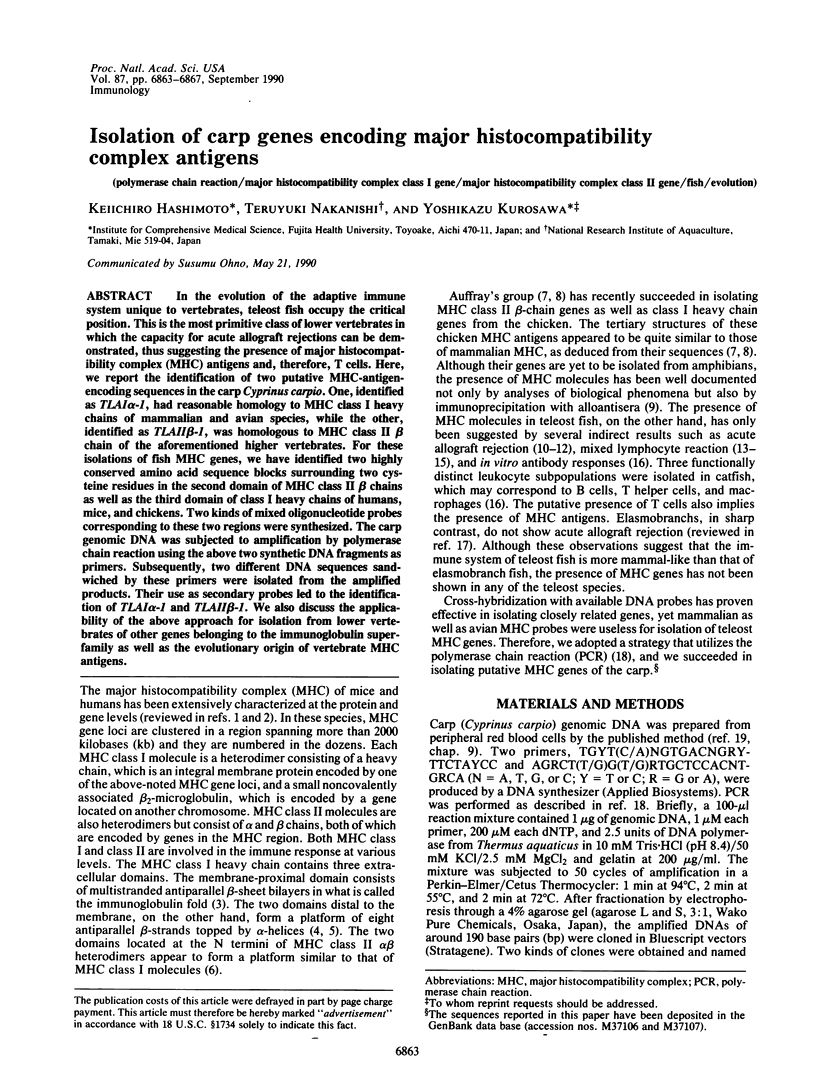
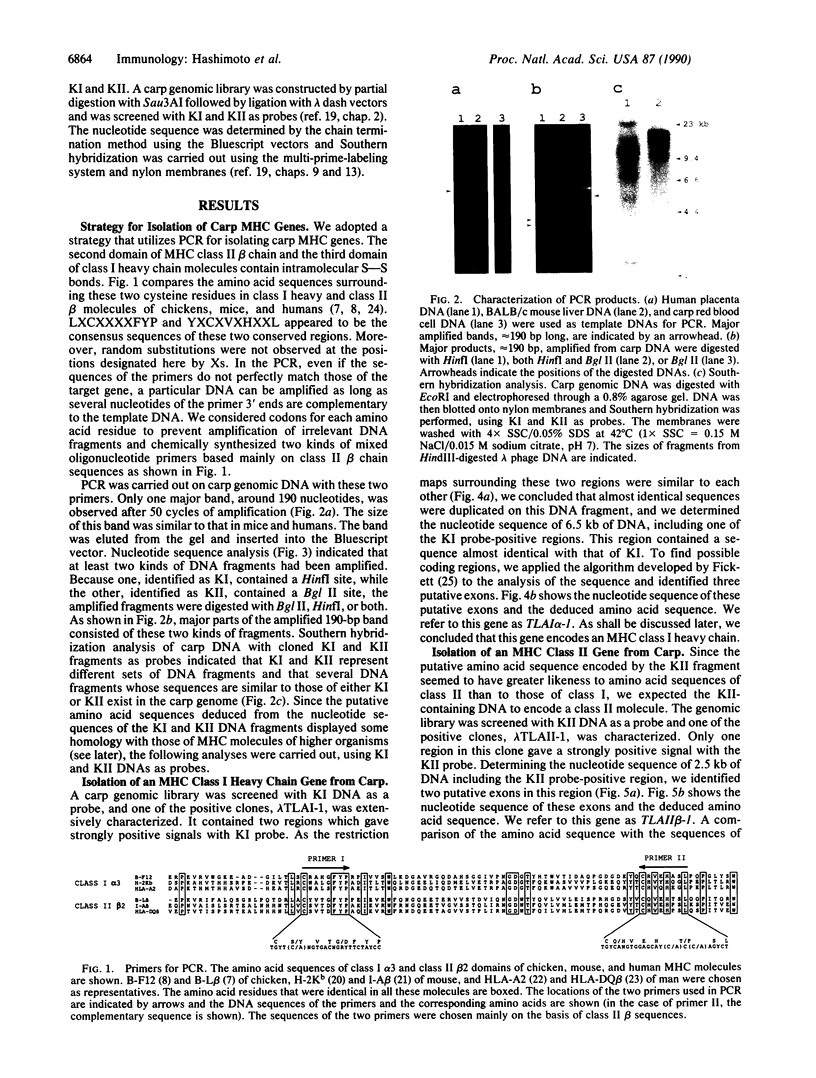
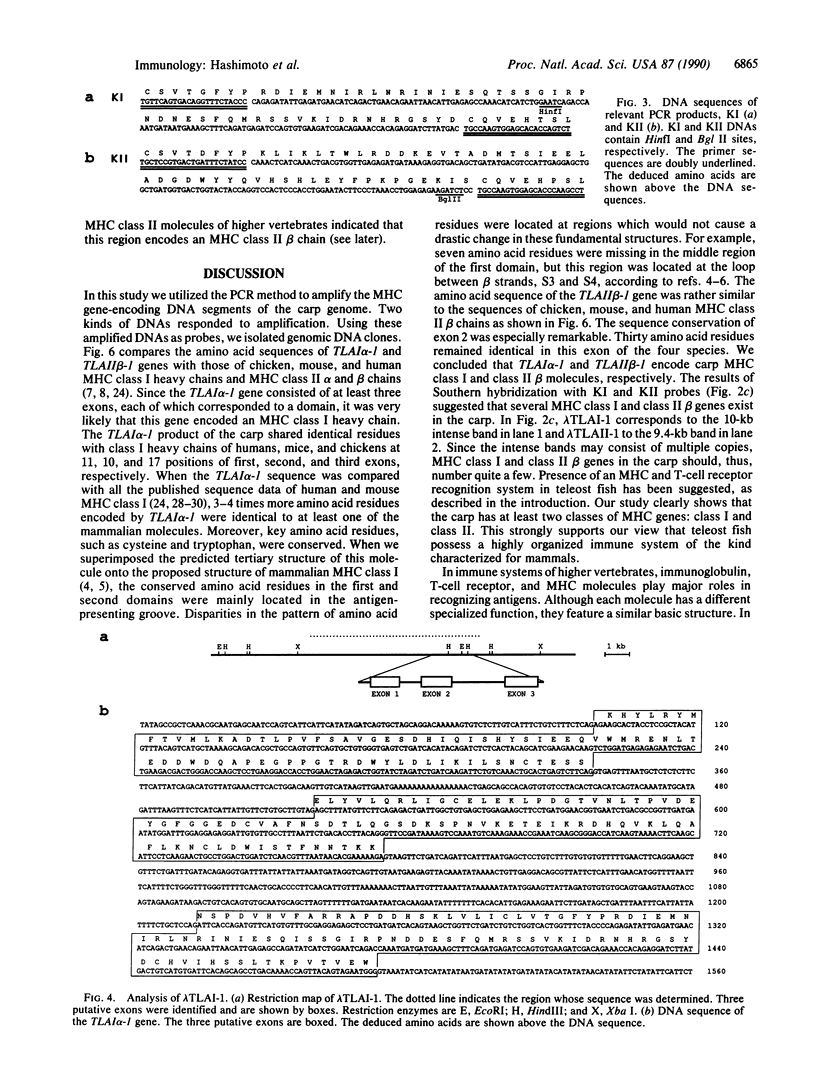
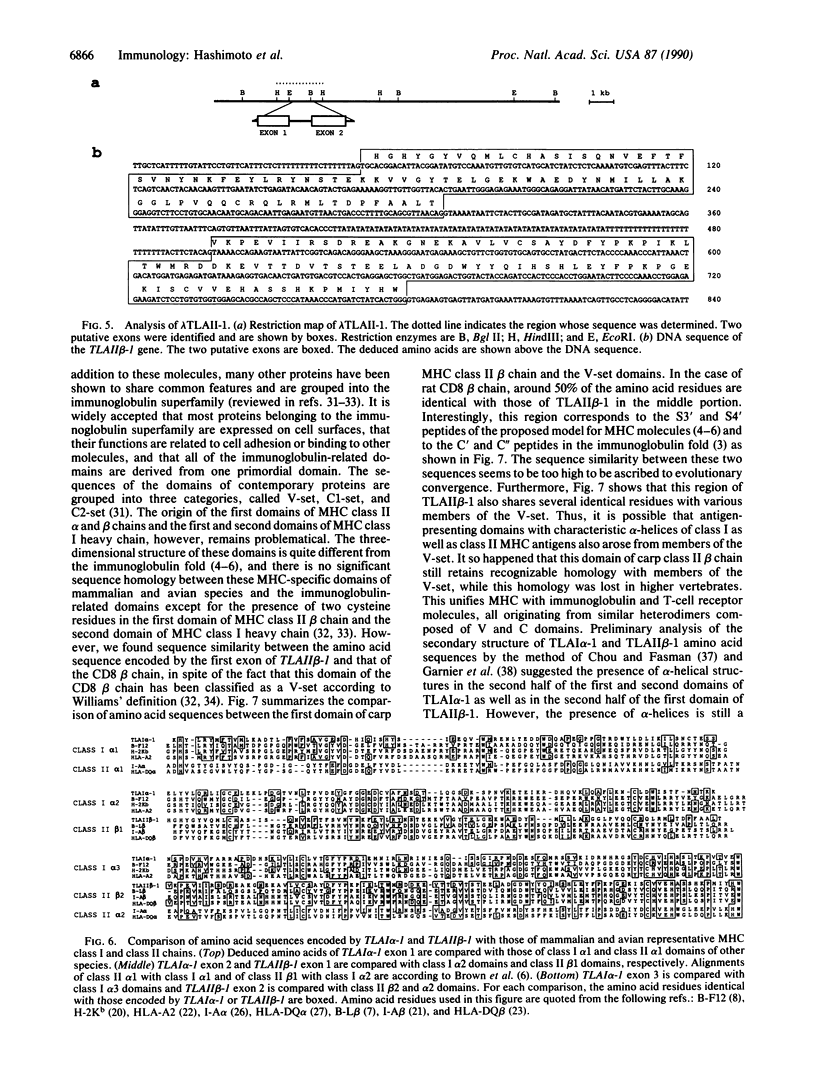
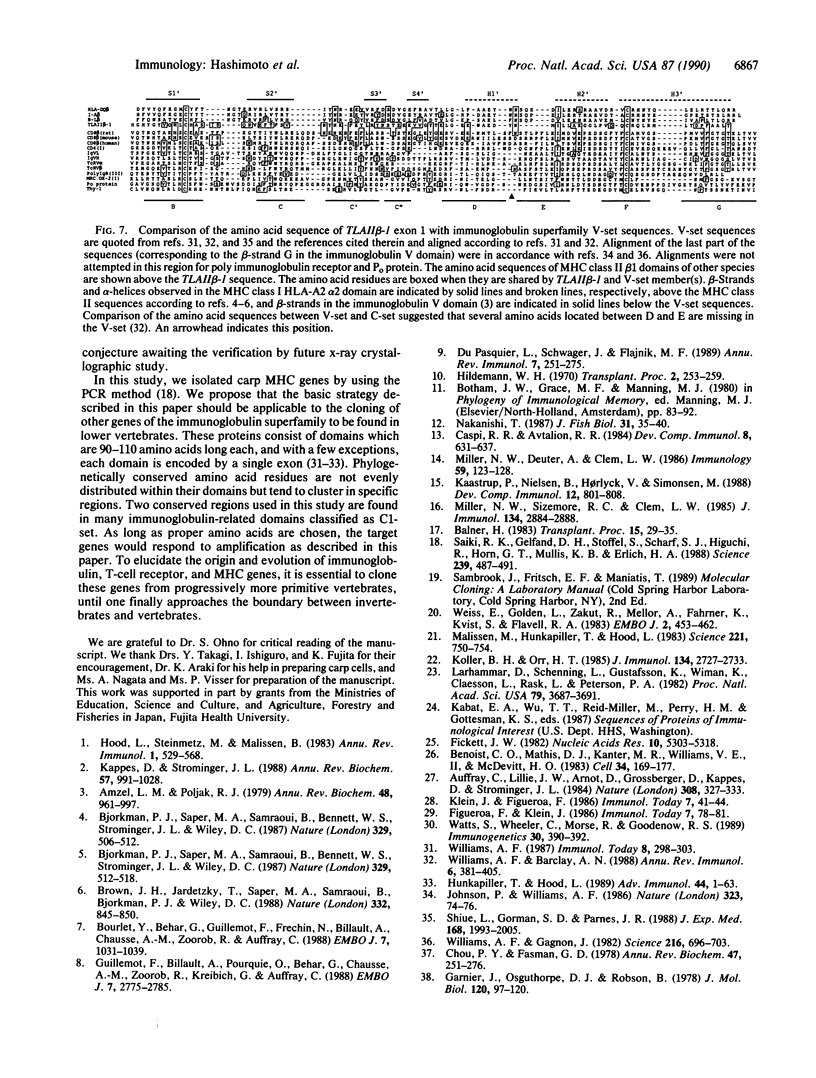
Images in this article
Selected References
These references are in PubMed. This may not be the complete list of references from this article.
- Amzel L. M., Poljak R. J. Three-dimensional structure of immunoglobulins. Annu Rev Biochem. 1979;48:961–997. doi: 10.1146/annurev.bi.48.070179.004525. [DOI] [PubMed] [Google Scholar]
- Auffray C., Lillie J. W., Arnot D., Grossberger D., Kappes D., Strominger J. L. Isotypic and allotypic variation of human class II histocompatibility antigen alpha-chain genes. Nature. 1984 Mar 22;308(5957):327–333. doi: 10.1038/308327a0. [DOI] [PubMed] [Google Scholar]
- Benoist C. O., Mathis D. J., Kanter M. R., Williams V. E., 2nd, McDevitt H. O. Regions of allelic hypervariability in the murine A alpha immune response gene. Cell. 1983 Aug;34(1):169–177. doi: 10.1016/0092-8674(83)90147-2. [DOI] [PubMed] [Google Scholar]
- Bjorkman P. J., Saper M. A., Samraoui B., Bennett W. S., Strominger J. L., Wiley D. C. Structure of the human class I histocompatibility antigen, HLA-A2. Nature. 1987 Oct 8;329(6139):506–512. doi: 10.1038/329506a0. [DOI] [PubMed] [Google Scholar]
- Bjorkman P. J., Saper M. A., Samraoui B., Bennett W. S., Strominger J. L., Wiley D. C. The foreign antigen binding site and T cell recognition regions of class I histocompatibility antigens. Nature. 1987 Oct 8;329(6139):512–518. doi: 10.1038/329512a0. [DOI] [PubMed] [Google Scholar]
- Bourlet Y., Béhar G., Guillemot F., Fréchin N., Billault A., Chaussé A. M., Zoorob R., Auffray C. Isolation of chicken major histocompatibility complex class II (B-L) beta chain sequences: comparison with mammalian beta chains and expression in lymphoid organs. EMBO J. 1988 Apr;7(4):1031–1039. doi: 10.1002/j.1460-2075.1988.tb02910.x. [DOI] [PMC free article] [PubMed] [Google Scholar]
- Brown J. H., Jardetzky T., Saper M. A., Samraoui B., Bjorkman P. J., Wiley D. C. A hypothetical model of the foreign antigen binding site of class II histocompatibility molecules. Nature. 1988 Apr 28;332(6167):845–850. doi: 10.1038/332845a0. [DOI] [PubMed] [Google Scholar]
- Caspi R. R., Avtalion R. R. The mixed leukocyte reaction (MLR) in carp: bidirectional and undirectional MLR responses. Dev Comp Immunol. 1984 Summer;8(3):631–637. doi: 10.1016/0145-305x(84)90095-8. [DOI] [PubMed] [Google Scholar]
- Chou P. Y., Fasman G. D. Empirical predictions of protein conformation. Annu Rev Biochem. 1978;47:251–276. doi: 10.1146/annurev.bi.47.070178.001343. [DOI] [PubMed] [Google Scholar]
- Du Pasquier L., Schwager J., Flajnik M. F. The immune system of Xenopus. Annu Rev Immunol. 1989;7:251–275. doi: 10.1146/annurev.iy.07.040189.001343. [DOI] [PubMed] [Google Scholar]
- Fickett J. W. Recognition of protein coding regions in DNA sequences. Nucleic Acids Res. 1982 Sep 11;10(17):5303–5318. doi: 10.1093/nar/10.17.5303. [DOI] [PMC free article] [PubMed] [Google Scholar]
- Garnier J., Osguthorpe D. J., Robson B. Analysis of the accuracy and implications of simple methods for predicting the secondary structure of globular proteins. J Mol Biol. 1978 Mar 25;120(1):97–120. doi: 10.1016/0022-2836(78)90297-8. [DOI] [PubMed] [Google Scholar]
- Guillemot F., Billault A., Pourquié O., Béhar G., Chaussé A. M., Zoorob R., Kreibich G., Auffray C. A molecular map of the chicken major histocompatibility complex: the class II beta genes are closely linked to the class I genes and the nucleolar organizer. EMBO J. 1988 Sep;7(9):2775–2785. doi: 10.1002/j.1460-2075.1988.tb03132.x. [DOI] [PMC free article] [PubMed] [Google Scholar]
- Hildemann W. H. Transplantation immunity in fishes: Agnatha, Chondrichthyes and Osteichthyes. Transplant Proc. 1970 Jun;2(2):253–259. [PubMed] [Google Scholar]
- Hood L., Steinmetz M., Malissen B. Genes of the major histocompatibility complex of the mouse. Annu Rev Immunol. 1983;1:529–568. doi: 10.1146/annurev.iy.01.040183.002525. [DOI] [PubMed] [Google Scholar]
- Hunkapiller T., Hood L. Diversity of the immunoglobulin gene superfamily. Adv Immunol. 1989;44:1–63. doi: 10.1016/s0065-2776(08)60639-2. [DOI] [PubMed] [Google Scholar]
- Johnson P., Williams A. F. Striking similarities between antigen receptor J pieces and sequence in the second chain of the murine CD8 antigen. Nature. 1986 Sep 4;323(6083):74–76. doi: 10.1038/323074a0. [DOI] [PubMed] [Google Scholar]
- Kaastrup P., Nielsen B., Hørlyck V., Simonsen M. Mixed lymphocyte reactions (MLR) in rainbow trout (Salmo gairdneri) sibling. Dev Comp Immunol. 1988 Fall;12(4):801–808. doi: 10.1016/0145-305x(88)90054-7. [DOI] [PubMed] [Google Scholar]
- Kappes D., Strominger J. L. Human class II major histocompatibility complex genes and proteins. Annu Rev Biochem. 1988;57:991–1028. doi: 10.1146/annurev.bi.57.070188.005015. [DOI] [PubMed] [Google Scholar]
- Koller B. H., Orr H. T. Cloning and complete sequence of an HLA-A2 gene: analysis of two HLA-A alleles at the nucleotide level. J Immunol. 1985 Apr;134(4):2727–2733. [PubMed] [Google Scholar]
- Larhammar D., Schenning L., Gustafsson K., Wiman K., Claesson L., Rask L., Peterson P. A. Complete amino acid sequence of an HLA-DR antigen-like beta chain as predicted from the nucleotide sequence: similarities with immunoglobulins and HLA-A, -B, and -C antigens. Proc Natl Acad Sci U S A. 1982 Jun;79(12):3687–3691. doi: 10.1073/pnas.79.12.3687. [DOI] [PMC free article] [PubMed] [Google Scholar]
- Malissen M., Hunkapiller T., Hood L. Nucleotide sequence of a light chain gene of the mouse I-A subregion: A beta d. Science. 1983 Aug 19;221(4612):750–754. doi: 10.1126/science.6410508. [DOI] [PubMed] [Google Scholar]
- Miller N. W., Deuter A., Clem L. W. Phylogeny of lymphocyte heterogeneity: the cellular requirements for the mixed leucocyte reaction with channel catfish. Immunology. 1986 Sep;59(1):123–128. [PMC free article] [PubMed] [Google Scholar]
- Miller N. W., Sizemore R. C., Clem L. W. Phylogeny of lymphocyte heterogeneity: the cellular requirements for in vitro antibody responses of channel catfish leukocytes. J Immunol. 1985 May;134(5):2884–2888. [PubMed] [Google Scholar]
- Saiki R. K., Gelfand D. H., Stoffel S., Scharf S. J., Higuchi R., Horn G. T., Mullis K. B., Erlich H. A. Primer-directed enzymatic amplification of DNA with a thermostable DNA polymerase. Science. 1988 Jan 29;239(4839):487–491. doi: 10.1126/science.2448875. [DOI] [PubMed] [Google Scholar]
- Shiue L., Gorman S. D., Parnes J. R. A second chain of human CD8 is expressed on peripheral blood lymphocytes. J Exp Med. 1988 Dec 1;168(6):1993–2005. doi: 10.1084/jem.168.6.1993. [DOI] [PMC free article] [PubMed] [Google Scholar]
- Watts S., Wheeler C., Morse R., Goodenow R. S. Amino acid comparison of the class I antigens of mouse major histocompatibility complex. Immunogenetics. 1989;30(5):390–392. doi: 10.1007/BF02425281. [DOI] [PubMed] [Google Scholar]
- Weiss E., Golden L., Zakut R., Mellor A., Fahrner K., Kvist S., Flavell R. A. The DNA sequence of the H-2kb gene: evidence for gene conversion as a mechanism for the generation of polymorphism in histocompatibilty antigens. EMBO J. 1983;2(3):453–462. doi: 10.1002/j.1460-2075.1983.tb01444.x. [DOI] [PMC free article] [PubMed] [Google Scholar]
- Williams A. F., Barclay A. N. The immunoglobulin superfamily--domains for cell surface recognition. Annu Rev Immunol. 1988;6:381–405. doi: 10.1146/annurev.iy.06.040188.002121. [DOI] [PubMed] [Google Scholar]
- Williams A. F., Gagnon J. Neuronal cell Thy-1 glycoprotein: homology with immunoglobulin. Science. 1982 May 14;216(4547):696–703. doi: 10.1126/science.6177036. [DOI] [PubMed] [Google Scholar]



